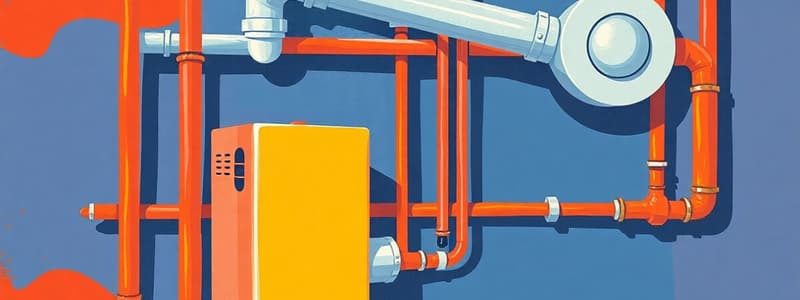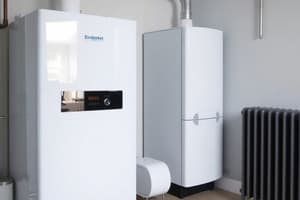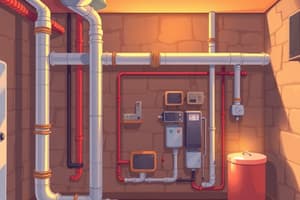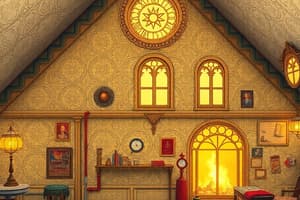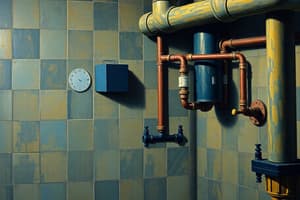Podcast
Questions and Answers
Before isolating a heating system for the day in cold weather, in a flat owned by an elderly person, a plumber should:
Before isolating a heating system for the day in cold weather, in a flat owned by an elderly person, a plumber should:
- Refuse to carry out the job at all costs
- Ensure that an alternative means of heating is available (correct)
- Only carry out the work if two plumbers are available
- Get on with the work as fast as possible
A customer reports that water drips from under the cap of a manual radiator valve when it is opened. The most likely cause will be a:
A customer reports that water drips from under the cap of a manual radiator valve when it is opened. The most likely cause will be a:
- Faulty spindle
- Defective valve seating
- Defective packing gland (correct)
- Corroded wheelhead
The revised building regulations Part L1 require that when fitting a new oil fired heating system, the system should be:
The revised building regulations Part L1 require that when fitting a new oil fired heating system, the system should be:
- Gravity hot water and pumped heating
- Fully pumped with a boiler interlock (correct)
- Installed by CORGI (Gas safe) registered plumbers
- Heated by combination boiler only
On a fully pumped system using a three port mid-position valve, neither the heating nor the hot water can be run independently. The most likely cause is that the:
On a fully pumped system using a three port mid-position valve, neither the heating nor the hot water can be run independently. The most likely cause is that the:
Which of the following components is recommended to be installed together with a frost thermostat, to reduce energy consumption when the thermostat activates in wintry conditions?
Which of the following components is recommended to be installed together with a frost thermostat, to reduce energy consumption when the thermostat activates in wintry conditions?
The upstairs radiators in a fully pumped central heating system (including hot water) are warming up in the summer months when the heating circuit is isolated, the downstairs radiators remain cold. Which of the following could be the cause of the problem?
The upstairs radiators in a fully pumped central heating system (including hot water) are warming up in the summer months when the heating circuit is isolated, the downstairs radiators remain cold. Which of the following could be the cause of the problem?
A fault has been identified on the wiring to a programmer. Before carrying out any work, a plumber should:
A fault has been identified on the wiring to a programmer. Before carrying out any work, a plumber should:
Where would you find the legal requirements regarding temperature control of heating and hot water system installations?
Where would you find the legal requirements regarding temperature control of heating and hot water system installations?
Details of the heat output of a specific heat emitter can be found in:
Details of the heat output of a specific heat emitter can be found in:
A Disadvantage of using a one-pipe heating system is that:
A Disadvantage of using a one-pipe heating system is that:
Filling an open vented central heating system would be carried out through:
Filling an open vented central heating system would be carried out through:
A 3-port valve, programmer, room thermostat, a cylinder thermostat and TRV's would normally be used on:
A 3-port valve, programmer, room thermostat, a cylinder thermostat and TRV's would normally be used on:
On a fully pumped system, an automatic air release valve is usually installed at the:
On a fully pumped system, an automatic air release valve is usually installed at the:
A boiler that works on the principle of extracting heat from otherwise wasted flue gases is known as:
A boiler that works on the principle of extracting heat from otherwise wasted flue gases is known as:
On an open vented system, the primary vent must be installed at least 450mm above the feed and expansion cistern in order to:
On an open vented system, the primary vent must be installed at least 450mm above the feed and expansion cistern in order to:
The main reason for mounting a radiator above the top of a skirting board is to:
The main reason for mounting a radiator above the top of a skirting board is to:
The recommended position of a cylinder thermostat from the base of the cylinder is:
The recommended position of a cylinder thermostat from the base of the cylinder is:
In an open vented fully pumped system, positioning the open vent and cold feed to the suction side of the pump:
In an open vented fully pumped system, positioning the open vent and cold feed to the suction side of the pump:
A single feed indirect cylinder is to be replaced with a fully indirect pattern. Which one of the following additional main components will need to be installed?
A single feed indirect cylinder is to be replaced with a fully indirect pattern. Which one of the following additional main components will need to be installed?
The common pipework connection on a 3-port mid.position valve is port:
The common pipework connection on a 3-port mid.position valve is port:
An advantage of installing an automatic bypass valve on systems fitted with thermostatic radiator valves is to:
An advantage of installing an automatic bypass valve on systems fitted with thermostatic radiator valves is to:
One purpose of an open vent pipe on a vented central heating system is to:
One purpose of an open vent pipe on a vented central heating system is to:
The first action that should be carried out prior to conducting soundness testing on a central heating system, is to:
The first action that should be carried out prior to conducting soundness testing on a central heating system, is to:
The recommended pressure when testing exposed heating systems pipework is:
The recommended pressure when testing exposed heating systems pipework is:
An existing two pipe system installation can be confirmed by checking that:
An existing two pipe system installation can be confirmed by checking that:
When a heating system is running, hot water discharges from the vent pipe to the feed and expansion cistern. The most likely cause is the the:
When a heating system is running, hot water discharges from the vent pipe to the feed and expansion cistern. The most likely cause is the the:
One of the requirements of the revised Building regulations Part L1 regarding new installations is that the system should be:
One of the requirements of the revised Building regulations Part L1 regarding new installations is that the system should be:
On a fully pumped system, the hot water circuit is running constantly. The most probable cause is that the:
On a fully pumped system, the hot water circuit is running constantly. The most probable cause is that the:
Two radiators in a heating system fitted with thermostatic radiator valves are not warming up. One radiator is on the ground floor and one is on the first floor, and all the other radiators are working correctly. What is the most likely cause of the problem?
Two radiators in a heating system fitted with thermostatic radiator valves are not warming up. One radiator is on the ground floor and one is on the first floor, and all the other radiators are working correctly. What is the most likely cause of the problem?
A fault has been identified on a 3-port valve. Which one of the following safety precautions should be observed before carrying out any work?
A fault has been identified on a 3-port valve. Which one of the following safety precautions should be observed before carrying out any work?
Flashcards
Isolating a Heating System
Isolating a Heating System
Ensure an alternative means of heating is available before isolating an elderly person's heating system in cold weather.
Radiator Valve Drip
Radiator Valve Drip
The most likely cause is a defective packing gland.
New Oil Fired Heating System
New Oil Fired Heating System
Fully pumped with a boiler interlock.
Fully Pumped System Issue
Fully Pumped System Issue
Signup and view all the flashcards
Frost Thermostat Component
Frost Thermostat Component
Signup and view all the flashcards
Upstairs Radiators Warming Issue
Upstairs Radiators Warming Issue
Signup and view all the flashcards
Wiring Fault Safety
Wiring Fault Safety
Signup and view all the flashcards
Heating System Temp Control
Heating System Temp Control
Signup and view all the flashcards
Heat Emitter Info
Heat Emitter Info
Signup and view all the flashcards
One-Pipe Heating System
One-Pipe Heating System
Signup and view all the flashcards
Filling an Open Vented System
Filling an Open Vented System
Signup and view all the flashcards
3-Port Valve Use
3-Port Valve Use
Signup and view all the flashcards
Automatic Air Release Valve Install
Automatic Air Release Valve Install
Signup and view all the flashcards
Condensing Boiler
Condensing Boiler
Signup and view all the flashcards
Primary Vent Installation
Primary Vent Installation
Signup and view all the flashcards
Radiator Mounting Reason
Radiator Mounting Reason
Signup and view all the flashcards
Cylinder Thermostat Position
Cylinder Thermostat Position
Signup and view all the flashcards
Positioning Open Vent and Pump
Positioning Open Vent and Pump
Signup and view all the flashcards
Feed Indirect Cylinder
Feed Indirect Cylinder
Signup and view all the flashcards
3-Port Valve Connection
3-Port Valve Connection
Signup and view all the flashcards
Study Notes
- Study notes based on plumbing questions
Question 1: Isolating a Heating System in Cold Weather
- When isolating a heating system in cold weather for an elderly person, the plumber should ensure an alternative heating source is available.
Question 2: Water Dripping from Radiator Valve Cap
- If water drips from under the cap of a manual radiator valve when opened, the most likely cause is a defective packing gland.
Question 3: Revised Building Regulations Part L1
- The revised building regulations Part L1 dictate that when fitting a new oil-fired heating system, it should be fully pumped with a boiler interlock.
Question 4: Three-Port Mid-Position Valve System Issue
- If neither heating nor hot water can run independently on a fully pumped system with a three-port mid-position valve, the likely cause is a defective 3-port valve.
Question 5: Frost Thermostat Component
- A pipe thermostat needs to be installed with a frost thermostat to reduce energy consumption when the thermostat activates in wintry conditions.
Question 6: Upstairs Radiators Warming in Summer
- If upstairs radiators warm up in summer while the heating circuit is isolated, but downstairs radiators remain cold, the motorised valve on the heating circuit likely failed in the fully open position.
Question 7: Wiring Fault on Programmer
- If you identify the wiring is at fault on a programmer, shut off the supply at the fused spur, then remove and retain the fuse, and check for safe isolation.
Question 8: Legal Requirements for Temperature Control
- Legal requirements for temperature control of heating and hot water system installations can be found in Building Regulations.
Question 9: Heat Output of Specific Heat Emitter Details
- Details regarding the heat output of a specific heat emitter can be located in the manufacturer's brochures.
Question 10: Disadvantage of a One-Pipe Heating System
- A disadvantage of using a one-pipe heating system is that the last radiator has a lower temperature than the first.
Question 11: Filling an Open Vented Central Heating System
- Filling an open vented central heating system is carried out through the cold feed from the Feed and expansion cistern.
Question 12: Components Used on Systems
- A 3-port valve, programmer, room thermostat, a cylinder thermostat and TRV's, would normally be used on a fully pumped system with a 3-port mid position zone valve.
Question 13: Automatic Air Release Valve
- On a fully pumped system, an automatic air release valve is usually installed at the highest point on the pumped primary flow.
Question 14: Boiler Extracting Heat from Flue Gases
- A boiler that works on the principle of extracting heat from otherwise wasted flue gases is known as a condensing boiler.
Question 15: Primary Vent Installation
- The primary vent needs to be installed at least 450mm above the feed and expansion cistern to avoid the possibility of air locks on an open vented system.
Question 16: Mounting a Radiator Above a Skirting Board
- Increase air circulation by mounting a radiator above the top of the skirting board.
Question 17: Cylinder Thermostat Positioning
- The recommended position of a cylinder thermostat from the base of the cylinder should be 1/3 height up.
Question 18: Positioning Open Vent and Cold Feed
- Positioning the open vent and cold feed to the suction side of the pump, in an open vented fully pumped system drastically decreases the efficiency of the system.
Question 19: Replacing a Single Feed Indirect Cylinder
- When replacing a single feed indirect cylinder with a fully indirect pattern, it may be necessary to install a F&E cistern as an additional main component.
Question 20: Common Pipework Connection on a 3-Port Valve
- The common pipework connection on a 3-port mid position valve is port AB.
Question 21: Installing an Automatic Bypass Valve
- Installing an automatic bypass valve on systems fitted with thermostatic radiator valves increases pump life by preventing it working against a "dead head".
Question 22: Purpose of an Open Vent Pipe
- One purpose of an open vent pipe on a vented central heating system is to provide a safety outlet should the system overheat.
Question 23: Soundness Testing Preparation
- The first action to carry out prior to conducting a soundness test on a central heating system is to carry out a visual inspection to ensure correct installation.
Question 24: Recommended Pressure for Testing Exposed Heating Systems
- Expose heating systems pipework needs to be tested at 1 1/2 times the working pressure.
Question 25: Confirming a Two Pipe System
- Ensure that both radiator valves are fed by an independent flow and return when confirming an existing two pipe system installation.
Question 26: Hot Water Discharge
- When a heating system is running, if hot water discharges from the vent pipe to the feed and expansion cistern, the most likely cause is the F&E cistern has been installed lower than the CWSC.
Question 27: Building Regulations Part L1
- One of the requirements of the revised Building Regulations Part L1 regarding new installations is that the system should have fully pumped hot water and heating.
Question 28: Fully Pumped System Hot Water Circuit Running Constantly
- If the hot water circuit is constantly running on a fully pumped system, then the most probable cause is that the motorised valve has developed an electrical fault.
Question 29: Radiators Not Heating Up
- If two radiators fail to warm up in a system fitted with thermostatic radiator valves, it is likely that the pressure pin on the TRV's has jammed..
Question 30: Safety Precautions for 3-Port Valve Fault
- If a fault has been identified on a 3-port valve, switch off the supply at the fused spur outlet, removing and retaining the fuse and testing for safe isolation before carrying out any work.
Studying That Suits You
Use AI to generate personalized quizzes and flashcards to suit your learning preferences.
